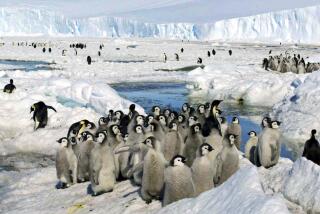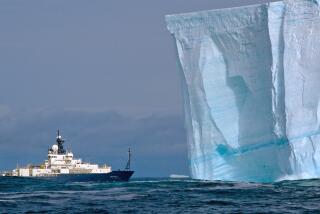Flying Over Antarctica
- Share via
My dream was about to come true.
I packed thermal underwear, added woolen socks, and boarded the Royal Viking Sea in Los Angeles. We sailed to Punta Arenas, Chile, in the Strait of Magellan, gateway to the South Pole.
I wanted to see some of the discoveries made up to 400 years ago by Ferdinand Magellan, Sir Francis Drake, Charles R. Darwin and Adm. Richard E. Byrd. But I’d have an advantage. I wouldn’t be on a sailing vessel. I’d be flying over the Antarctic in a chartered plane with 57 other passengers. The added cost for each was $620.
Somewhere near this area, Darwin reported finding an ostrich nest containing 27 eggs, each one 11 times the size of a hen’s egg.
I didn’t see any sign of life, human or otherwise--not an ostrich, a penguin, a seal, not even a puffin.
Our ship slowly nosed its way through the barren, ice-covered Chilean fiords. Small islets loomed on every side, looking like unfinished jigsaw puzzles . . . pieces crumbling away from the mainland.
A Light Snowfall
The weather grew colder and colder, the ship maneuvering carefully between low, white-frosted hills. A light snowfall fell into the sea and onto the decks. Snowflakes drifted against the portholes of my stateroom.
I put on my thermals and a cap, and wondered if I’d need snowshoes on deck.
That night, about midnight, I awakened, aware that the ship had stopped. The captain had announced that we would be taking on Chilean pilots to guide us through the maze of islets into Punta Arenas, through the perilous strait where so many ships had foundered. We had passed a 25-year-old wreck still moldering away on a spit of land.
In the morning, when the ship’s engines started up again, I went out to feel the icy air. The loudspeaker reported that the temperature was 30 degrees and would warm up to 37. The month was November, springtime in the Southern Hemisphere.
On deck, one of the passengers said, “This isn’t really cold. A Russian scientist once measured the temperature at the pole at 80 degrees below zero.”
On our port side was the frozen blue skeletal hand of the Mt. Wyndham Glacier, topped with a glove of soft snow reaching into the green sea, the southern end of the Andes range.
I considered a visit to King George Island where, every summer, the National Tourism Board of Chile operates the only guest house in Antarctica, a place of 20 rooms. At the moment, though, the ship felt very cozy. I reconsidered.
The scenery was magnificent. The Seno Glacier reached its bony arm into lapis lazuli water, a long strand of pearls draping across and dipping into a deep blue-tiled sauna.
Old Name in New Setting
Tracing our progress on the map, I saw intriguing names: Whaleboat Sound, Fury Harbor, Desolation Bay and Staten Island. At least there was one familiarname in this unfamiliar setting.
When we arrived at Punta Arenas Harbor, the 58 polar passengers were transferred by tender into town, then loaded onto a bus that took us to the airport, where we boarded the plane. We were embarking on our adventure, a triangular overflight. The longest leg was from Punta Arenas to the weather stations, then on to the Antarctic Peninsula and back to the ship.
From my comfortable window seat high above the Strait of Magellan, I listened as the commentator explained: “Below us is Tierra del Fuego, the southernmost point of the South American Continent.” As he ticked off points of interest, a flight attendant passed among us with drinks.
We could see nothing of what our guide was referring to. A heavy cloud cover hid everything, including Beagle Channel (made famous by Darwin in his “Voyage of the Beagle”), and I was beginning to wonder if the flight would be aborted, together with my $620.
The Clouds Lifted
Suddenly the clouds lifted, and so did my spirits. My dream was coming true. I could see the frozen world beneath, with Cape Horn in the distance, 840 kilometers from the pole. Frosted mountain snow cones rose from the green-slush Antarctic waters.
“Below you see the Shetland Islands.” Huge iced cupcakes seemed to be floating in the icy Drake Passage. I was flying toward the end of the world, above the circular, coldest, most arid continent.
Drake preceded Darwin by almost 2 1/2 centuries when he discovered Drake Passage. At the time Darwin traversed the strait, he thought that land connected South America with Antarctica. How could he have dreamed that there would be a race for the South Pole between Roald Amundsen and Robert F. Scott in 1911-12, with Amundsen winning by a month? That Scott, even with his Siberian ponies, would die in the attempt? Or that Byrd would one day fly over the Pole in an airplane?
As the cloud layer dispersed, the 11 Shetland Islands appeared, rising from the icy Drake Passage.
Antarctica showed its fantastic beauty. Snow-filled volcanic peaks pushed up from the rugged terrain, some reflecting into the icy ocean. Ice pinnacles towered above deep-blue water, like a swimming pool slide descending into a blue tub.
‘Mammals Cannot Survive’
“This ocean,” our guide explained, “divides the Pacific, Atlantic and Indian oceans. They are called the Antarctic Polar and Biological Fronts. Mammals cannot survive here. Even seals, penguins and puffins must feed from the sea. Four indigenous species of penguins lay their eggs in Antarctic rookeries, available only in the two summer months which are free from snow.”
From our 17,000-foot altitude we could see no penguin, puffin, seal or rookery.
As for human habitation, although the weather stations are staffed, the buildings are dots on a piece of crumpled white paper, with an occasional tall antenna sticking up.
In winter the size of the continent is doubled by the accumulation of ice and snow. Thus, from July to September the area is about 14 million square kilometers. Archeologists explain that 118 million years ago, the continent drifted away from other continents and is still moving toward South America.
Supplies used to be brought in by icebreaker ships and dog sled, and the trip took two days by ship. Today the bases are supplied by plane, flights taking 2 1/2 hours from Chile to the work sites and stations.
Nearby Chile has no diplomatic relations with the Soviet Union, hence none with the tiny Russian colony in Antarctica. But I learned that there are “friendly soccer matches with the Chilean Air Force men stationed at neighboring Marsh Base, on King George Island,” about 400 meters away. Marsh Base also has a small hotel, probably the southernmost public hostelry in the world.
The Chinese call their base “The Great Brazil Wall.” This sense of humor is endemic; there is no competition here. All pool their knowledge and cool their tempers. International cooperation is as essential as the survival it ensures, especially in deepest winter.
Open Territory
The year 1986 marked the 25th anniversary of the drafting of an international treaty making Antarctica open territory.
Below us more icebergs appeared, bobbing like frozen marshmallows in deep blue bays. Flat, snow-covered plateaus dripped like giant meringues over chocolate escarpments. Surging out of the ocean, rugged mountain ranges with their numerous extinct volcanoes bear testimony to prehistoric upheavals.
Antarctica is an artistic triumph; a sculpture garden frozen in time and space.
In the distance we saw Townsend Island and Tierra del Fuego. We were again presented with snacks and drinks, but hardly paid attention. The scenery appearing in the generous porthole windows was too distracting.
It will be eons--perhaps never--before Antarctica becomes a tourist mecca, even with the small hotel at Marsh Base that Chile is so proud of.
Back aboard the ship, which now seemed like home, I turned my face north for the return voyage, one of the few passengers to brave the deck walks alone. But I was hungry for the sign of land, real land, and kept shading my eyes for the coast of Patagonia.
People used to stare at me blankly and say, “Where’s Patagonia?” or “What’s Patagonia?” Now I can tell them I’ve been there, or at least sailed past it. The cool, dry plateau, wind-swept and sparsely populated, gently segues into the sea. Recently it has been found to have a huge undersea oil field, but it is also home for colonies of penguins, seals, puffins and a herd of 2,000 sperm whales.
By the time we berthed at Rio de Janeiro, I had discarded my thermals for tropical clothing. After returning from a trip to Antartica, what could be more appropriate than a bikini?
More to Read
Sign up for Essential California
The most important California stories and recommendations in your inbox every morning.
You may occasionally receive promotional content from the Los Angeles Times.













